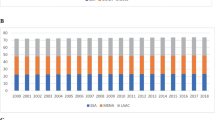Abstract
A critical discussion of a comparative growth analysis about Central and Eastern European (CEE) countries is performed. The main conclusion is that there was economic convergence for most CEE accession candidates, but not between them and Western Europe. Results do justify a separation into first and second-wave accession countries, but also undermine differences in Central and Eastern Europe between accession and non-accession countries.
This paper critically examines theories and empirical studies for three types of convergence, namely β,σ and club convergence. Each can be in absolute terms or conditional to the long-term equilibrium (steady state) for each country.
Empirical results are provided for all types of convergence from 1996 to 2000, both with population-weighted and non-weighted data. The analysis is performed for differently framed country subgroups considering even Western Europe for better comparability. Once absolute convergence is found through a unit root test about a standard deviation time series of cross-sectional income per capita, the regression coefficient for initial income per capita with the average growth over the sample period as dependent variable (β convergence) establishes the speed of this process. The same method applies to the conditional version by using the distance of the income from the corresponding steady state instead of the level of GDP. Then Markov chain probability matrixes (club convergence) provide information about the past behaviour of the whole cross-sectional income distribution over time, but also about intra-mobility of single countries.
Similar content being viewed by others

References
Barro, R.J. (1991). Economic growth in a cross section of countries. Quarterly Journal of Economics, 106(May), 407–443.
Barro, R.J. & Sala-i-Martin, X.X. (1992). Convergence. Journal of Political Economy, 100 (April), 223–251.
Barro, R.J. & Sala-i-Martin, X.X. (1995). Economic growth. New York: McGraw-Hill.
Baumol, W.J. (1986). Productivity growth, convergence and welfare: What the long-run data show, American Economic Review, 76(December), 1072–1085.
Ben-David, D. (1993). Equalizing exchange: Trade liberalization and income convergence.Quarterly Journal of Economics (November), 653–679.
Ben-David, D. (1996). Trade and convergence among countries. Journal of International Economics (May), 279–298.
Bianchi, M. (1995). Testing for convergence: A bootstrap test for multi-modality. Working Paper 36 (May), Bank of England.
Blanchard, O. (1997). Macroeconomics. New Jersey: Prentice-Hall.
Dixon, H.D. (2000). Economics and happiness: Introduction. In Dixon Huw D. (Ed.), Controversies in macroeconomics: Growth, trade and policy. Oxford: Blackwell Publishers.
Frank, R.H. (1997). The frame of reference as a public good. Economic Journal, 107 (November), 1832–1847.
Galor, O. (1996). Convergence? Inferences from theoretical models. Economic Journal, 106 (July), 1056–1069.
Gros, D. & Steinherr, A. (2001). The first ten years of transition: Planting the seeds of economic reform in Central and Eastern Europe. MIT Press.
Hall, R.E. & Jones, C.I. (1996). The productivity of nations.Working paper 5812 (November), NBER, Cambridge.
Heston, A. & Summers, R. (1991). The Penn World Table (Mark 5): An expanded set of international comparisons, 1950-1988. Quarterly Journal of Economics, 106 (May), 327–368.
Heston, A., Summers, R. & Aten, B. (2001). Penn World Table Version 6.0. Center for International Comparisons at the University of Pennsylvania (CICUP), December, http//:webhost.bridgew.edu/baten/.
Johnson, P.A. (2000). A nonparametric analysis of income convergence across the US states.Economics Letters, 69 (November), 219–223.
Jones, C.I. (1997). Convergence revisited. Journal of Economic Growth (June), 131–153.
Oswald, A.J. (1997). Happiness and economic performance. Economic Journal, 107 (November), 1815–1831.
Pindyck, R.S. & Rubinfeld, D.L. (1998). Econometric models and economic forecasts, (4th ed.). McGraw-Hill.
Pritchett, L. (1997). Divergence, big time. Journal of Economic Perspectives, 11, 3–17.
Quah, D.T. (1993a). Empirical cross-section dynamics in economic growth. Working Paper (December), London School of Economics.
Quah, D.T. (1993b). Galton's fallacy and tests of the convergence hypothesis. Scandinavian Journal of Economics, 95(4), 427–443.
Quah, D.T. (1996a). Convergence empirics across economies with (some) capital mobility.Journal of Economic Growth (March), 95–124.
Quah, D.T. (1996b). Twin peaks: Growth and convergence in models of distribution dynamics. Economic Journal(July), 1045–1055.
Quah, D.T. (1997). Empirics for growth and distribution: Stratification, polarization and convergence clubs. Journal of Economic Growth (March), 27–59.
Quah, D.T. (1999a). Ideas determining convergence clubs. Working Paper, London School of Economics.
Quah, D.T. (1999b). 6-109: Some dynamics of global inequality and growth. Working Paper manuscript (December), London School of Economics.
Sala-i-Martin, X.X. (1996). The classical approach to convergence of growth analysis. Economic Journal, 106 (July), 1019–1036.
Solow, R.M. (1956). A contribution to the theory of economic growth. Quarterly Journal of Economics, 70 (February), 65–94.
Solow, R.M. (2000). Growth Theory: An Exposition. (2nd ed.). New York and Oxford: Oxford University Press.
Thirlwall, A.P. (1999). Growth and Development. (6th ed.). London: Macmillan Press.
Valde' s, B. (1999). Economic Growth: Theory, Empirics and Policy. Cheltenham: Edward Elgar.
Author information
Authors and Affiliations
Rights and permissions
About this article
Cite this article
Amplatz, C. The Economic Convergence Performance of Central and Eastern European Countries. Economics of Planning 36, 273–295 (2003). https://doi.org/10.1023/B:ECOP.0000038266.65181.6a
Issue Date:
DOI: https://doi.org/10.1023/B:ECOP.0000038266.65181.6a



